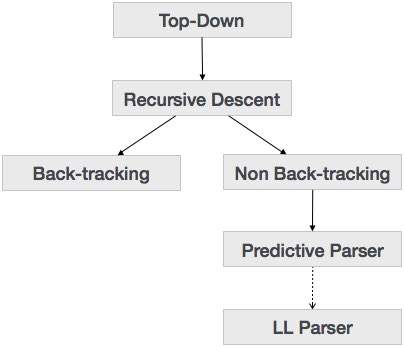Compiler Design
When an input string (source code or a program in some language) is given to a compiler, the compiler processes it in several phases, starting from lexical analysis (scans the input and divides it into tokens) to target code generation.
Syntax Analysis or Parsing is the second phase, i.e. after lexical analysis. It checks the syntactical structure of the given input, i.e. whether the given input is in the correct syntax (of the language in which the input has been written) or not. It does so by building a data structure, called a Parse tree or Syntax tree. The parse tree is constructed by using the predefined Grammar of the language and the input string. If the given input string can be produced with the help of the syntax tree (in the derivation process), the input string is found to be in the correct syntax.
Derivation
A derivation is basically a sequence of production rules, in order to get the input string. During parsing, we take two decisions for some sentential form of input:
- Deciding the non-terminal which is to be replaced.
- Deciding the production rule, by which, the non-terminal will be replaced.
To decide which non-terminal to be replaced with production rule, we can have two options.
Left-most Derivation
If the sentential form of an input is scanned and replaced from left to right, it is called left-most derivation. The sentential form derived by the left-most derivation is called the left-sentential form.
Right-most Derivation
If we scan and replace the input with production rules, from right to left, it is known as right-most derivation. The sentential form derived from the right-most derivation is called the right-sentential form.
TOP DOWN
The top-down parsing technique parses the input, and starts constructing a parse tree from the root node gradually moving down to the leaf nodes. The types of top-down parsing are depicted below:

BOTTOM-UP
Bottom-up parsing starts from the leaf nodes of a tree and works in upward direction till it reaches the root node. Here, we start from a sentence and then apply production rules in reverse manner in order to reach the start symbol. The image given below depicts the bottom-up parsers available.
LL vs. LR
| LL | LR |
|---|---|
| Does a leftmost derivation. | Does a rightmost derivation in reverse. |
| Starts with the root nonterminal on the stack. | Ends with the root nonterminal on the stack. |
| Ends when the stack is empty. | Starts with an empty stack. |
| Uses the stack for designating what is still to be expected. | Uses the stack for designating what is already seen. |
| Builds the parse tree top-down. | Builds the parse tree bottom-up. |
| Continuously pops a nonterminal off the stack, and pushes the corresponding right hand side. | Tries to recognize a right hand side on the stack, pops it, and pushes the corresponding nonterminal. |
| Expands the non-terminals. | Reduces the non-terminals. |
| Reads the terminals when it pops one off the stack. | Reads the terminals while it pushes them on the stack. |
| Pre-order traversal of the parse tree. | Post-order traversal of the parse tree. |
